Impact of Stress-Dependent Matrix and Fracture Properties on Shale Gas Production
Abstract
:1. Introduction
2. Model Description
2.1. Stress-Dependent Matrix Permeability
2.2. Stress-Dependent Fracture Permeability and Contact Surface Area
3. Results and Discussions
3.1. The Coupled Effect of Poro-Elastic Compaction and Slip Flow
3.2. The Combined Effect of Stress-Dependent Matrix and Fracture Property on Shale Gas Production
4. Conclusions
- The coupled poro-elastic and slippage model predicts only slightly higher gas production than the model with only the poro-elastic effect or the model with decoupled poro-elastic and gas slippage-effect. The dominant factor that controls the gas production is still the poro-elastic effect (pore volume compaction).
- Fracture surface area loss was found to affect shale gas production, but the impact is not significant compared with the fracture permeability loss.
- The impact of stress-dependent fracture property happens at the very early time during the production, while the impact of stress-dependent matrix property is mainly dominated for the longer-term gas production. The matrix permeability evolution can have a significant impact on shale gas production, especially for cases with highly conductive fractures.
Acknowledgments
Author Contributions
Conflicts of Interest
References
- Patzek, T.; Male, F.; Marder, M. A simple model of gas production from hydrofractured horizontal wells in shales. AAPG Bull. 2014, 98, 2507–2529. [Google Scholar] [CrossRef]
- Valkó, P.P.; Lee, W.J. A better way to forecast production from unconventional gas wells. In Proceedings of the SPE Annual Technical Conference and Exhibition, Florence, Italy, 19–22 September 2010. [Google Scholar]
- Klinkenberg, L.J. The Permeability of Porous Media to Liquids and Gases; Drilling and Production Practice; American Petroleum Institute: New York, NY, USA, 1941. [Google Scholar]
- Tanikawa, W.; Shimamoto, T. Klinkenberg effect for gas permeability and its comparison to water permeability for porous sedimentary rocks. Hydrol. Earth Syst. Sci. Discuss. 2006, 3, 1315–1338. [Google Scholar] [CrossRef]
- Gensterblum, Y.; Ghanizadeh, A.; Krooss, B.M. Gas permeability measurements on Australian subbituminous coals: Fluid dynamic and poroelastic aspects. J. Nat. Gas Sci. Eng. 2014, 19, 202–214. [Google Scholar] [CrossRef]
- Suarez-Rivera, R.; Burghardt, J. Geomechanics considerations for hydraulic fracture productivity. In Proceedings of the 47th US Rock Mechanics/Geomechanics Symposium, San Francisco, CA, USA, 23–26 June 2013. [Google Scholar]
- Cho, Y.; Ozkan, E.; Apaydin, O.G. Pressure-dependent natural-fracture permeability in shale and its effect on shale-gas well production. SPE Reserv. Eval. Eng. 2013, 16, 216–228. [Google Scholar] [CrossRef]
- Aybar, U.; Yu, W.; Eshkalak, M.O.; Sepehrnoori, K.; Patzek, T. Evaluation of production losses from unconventional shale reservoirs. J. Nat. Gas Sci. Eng. 2015, 23, 509–516. [Google Scholar] [CrossRef]
- Huo, D.; Benson, S.M. An experimental investigation of stress-dependent permeability and permeability hysteresis behavior in rock fractures. In Fluid Dynamics in Complex Fractured-Porous Systems; John Wiley & Sons, Inc.: Hoboken, NJ, USA, 2015; pp. 99–114. [Google Scholar]
- Pyrak-Nolte, L.J.; Nolte, D.D. Approaching a universal scaling relationship between fracture stiffness and fluid flow. Nat. Commun. 2016, 7, 10663. [Google Scholar] [CrossRef] [PubMed]
- Ostensen, R.W. The effect of stress-dependent permeability on gas production and well testing. SPE Form. Eval. 1986, 1, 227–235. [Google Scholar] [CrossRef]
- Gensterblum, Y.; Ghanizadeh, A.; Cuss, R.J.; Amann-Hildenbrand, A.; Krooss, B.M.; Clarkson, C.R.; Harrington, J.F.; Zoback, M.D. Gas transport and storage capacity in shale gas reservoirs–A review. Part A: Transport processes. J. Unconv. Oil Gas Resour. 2015, 12, 87–122. [Google Scholar] [CrossRef]
- Heller, R.; Vermylen, J.; Zoback, M. Experimental investigation of matrix permeability of gas shales. AAPG Bull. 2014, 98, 975–995. [Google Scholar] [CrossRef]
- Valkó, P.; Economides, M.J. Hydraulic Fracture Mechanics; Wiley: New York, NY, USA, 1995. [Google Scholar]
- Ertekin, T.; King, G.A.; Schwerer, F.C. Dynamic gas slippage: A unique dual-mechanism approach to the flow of gas in tight formations. SPE Form. Eval. 1986, 1, 43–52. [Google Scholar] [CrossRef]
- Tang, G.H.; Tao, W.Q.; He, Y.L. Gas slippage effect on microscale porous flow using the lattice Boltzmann method. Phys. Rev. E 2005, 72, 56301. [Google Scholar] [CrossRef] [PubMed]
- Zhang, W.M.; Meng, G.; Wei, X. A review on slip models for gas microflows. Microfluid. Nanofluid. 2012, 13, 845–882. [Google Scholar] [CrossRef]
- Alramahi, B.; Sundberg, M.I. Proppant embedment and conductivity of hydraulic fractures in shales. In Proceedings of the 46th US Rock Mechanics/Geomechanics Symposium, Chicago, IL, USA, 24–27 June 2012. [Google Scholar]
- Zhang, J.; Ouyang, L.; Zhu, D.; Hill, A.D. Experimental and numerical studies of reduced fracture conductivity due to proppant embedment in the shale reservoir. J. Pet. Sci. Eng. 2015, 130, 37–45. [Google Scholar] [CrossRef]
- Cao, H. Development of Techniques for General Purpose Simulators. Ph.D. Thesis, Stanford University, Stanford, CA, USA, 2002. [Google Scholar]
- Zhang, Y.; Gong, B.; Li, J.; Li, H. Discrete fracture modeling of 3D heterogeneous enhanced coalbed methane recovery with prismatic meshing. Energies 2015, 8, 6153–6176. [Google Scholar] [CrossRef]
- Al Ismail, M.I.; Zoback, M.D. Effects of rock mineralogy and pore structure on extremely low stress-dependent matrix permeability of unconventional shale gas and shale oil samples. R. Soc. Phil. Trans. A 2016, 374, 20150428. [Google Scholar] [CrossRef] [PubMed]
- Eshkalak, M.O.; Mohaghegh, S.D.; Esmaili, S. Geomechanical properties of unconventional shale reservoirs. J. Pet. Eng. 2014, 2014, 961641. [Google Scholar] [CrossRef]
- Eshkalak, M.O.; Al-shalabi, E.W.; Sanaei, A.; Aybar, U.; Sepehrnoori, K. Enhanced gas recovery by CO2 sequestration versus re-fracturing treatment in unconventional shale gas reservoirs. In Proceedings of the Abu Dhabi International Petroleum Exhibition and Conference, Abu Dhabi, UAE, 10–13 November 2014. [Google Scholar]
- Eaton, B.A. Fracture gradient prediction and its application in oilfield operations. J. Pet. Technol. 1969, 21. [Google Scholar] [CrossRef]


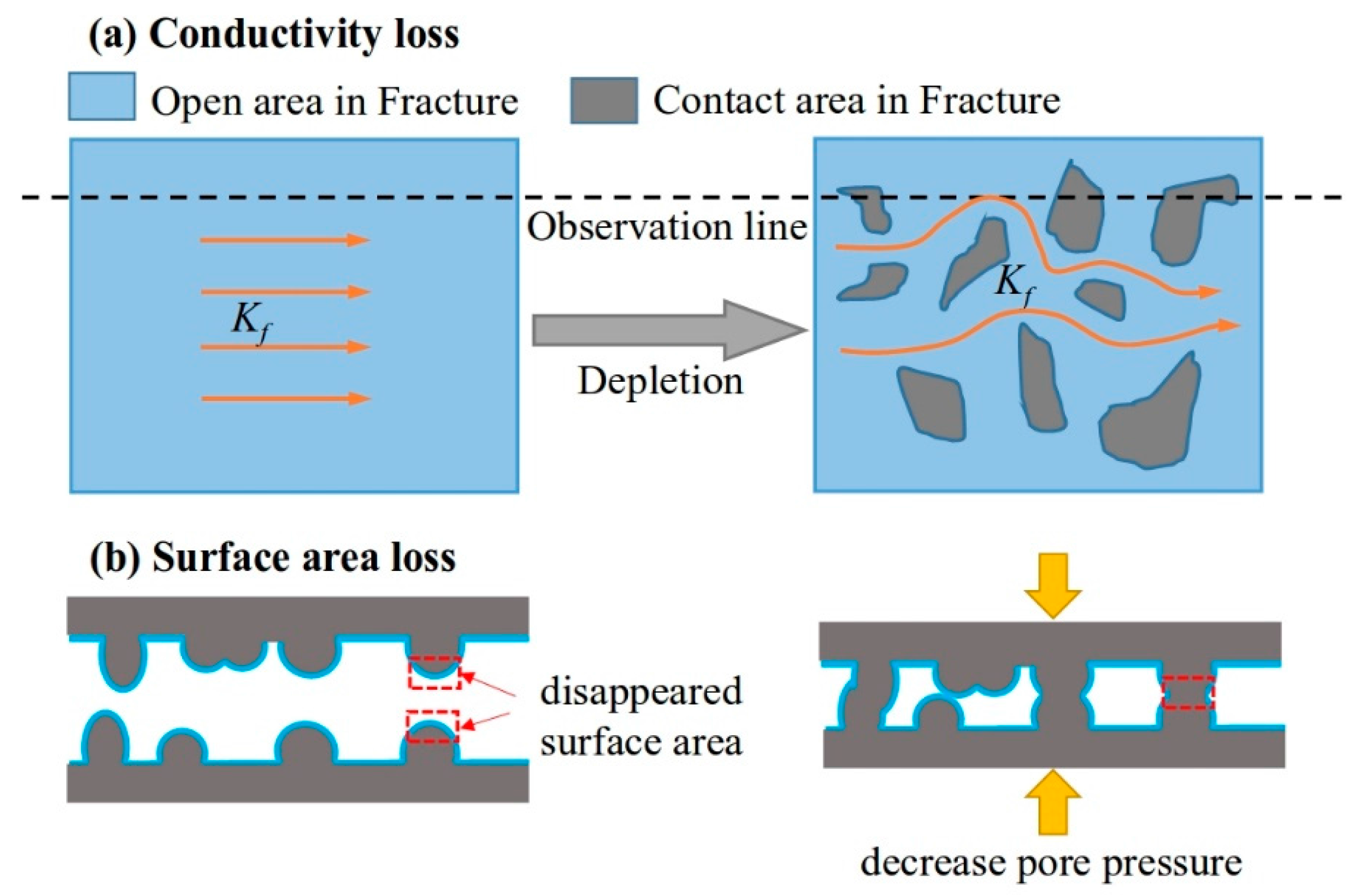

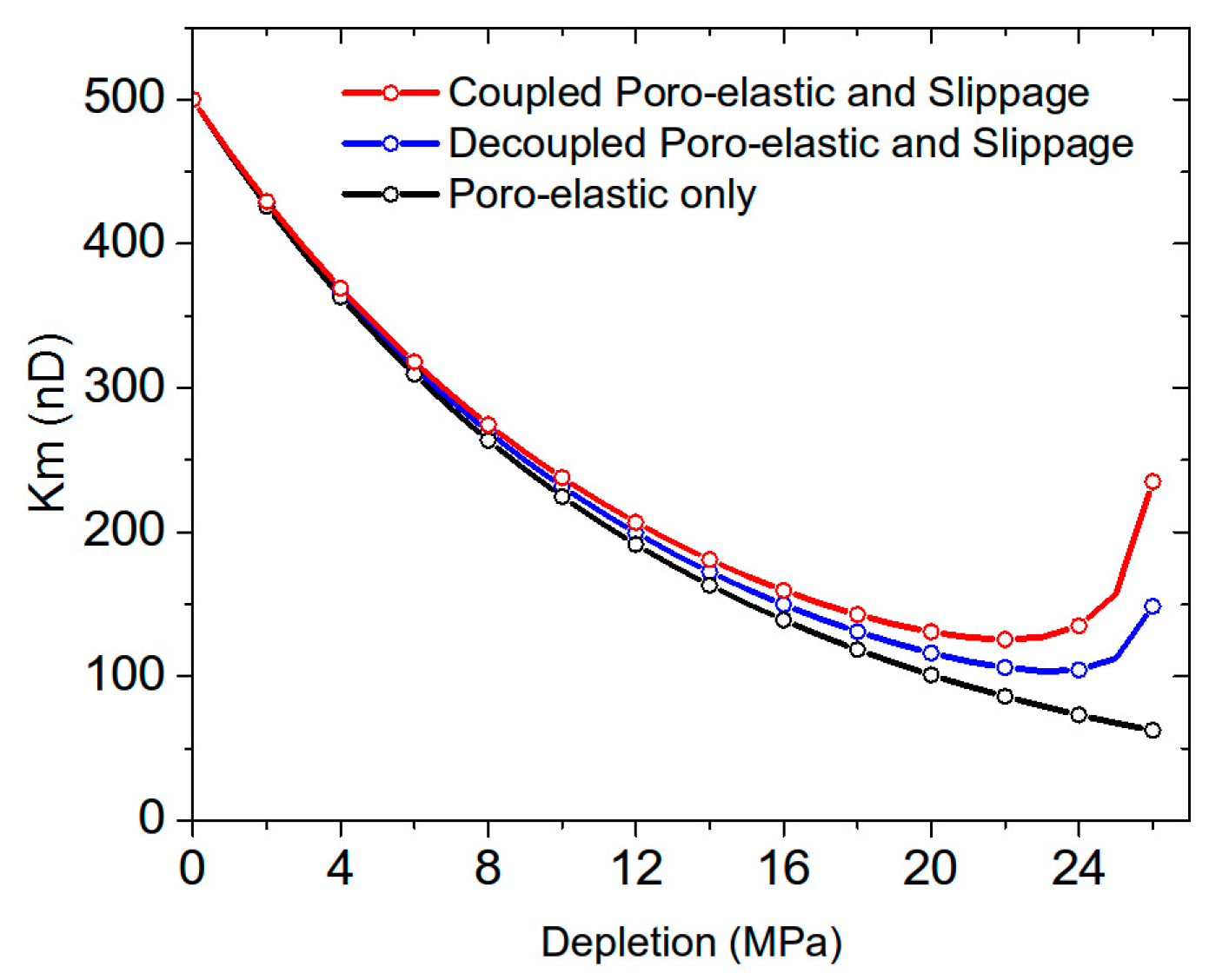
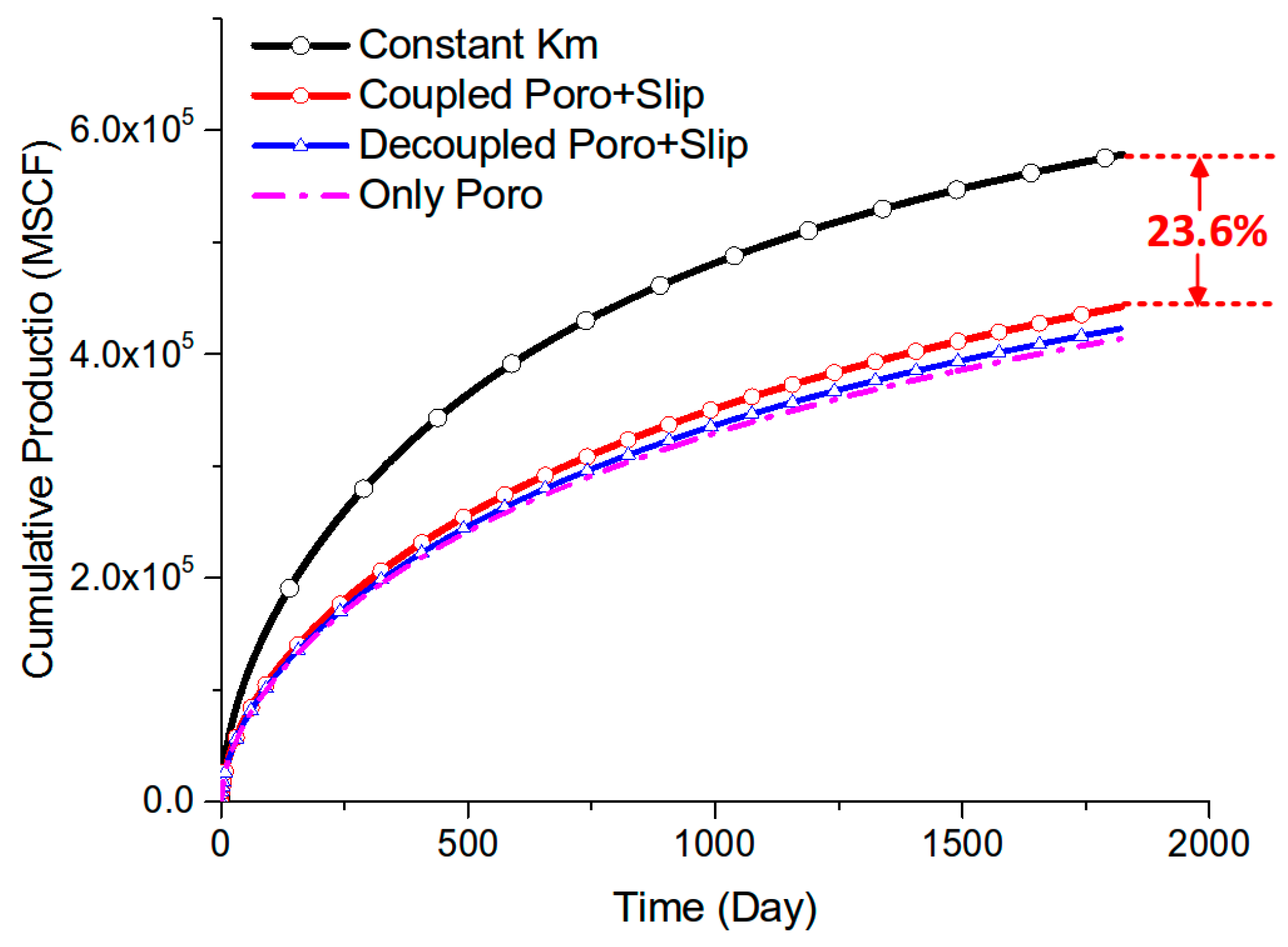
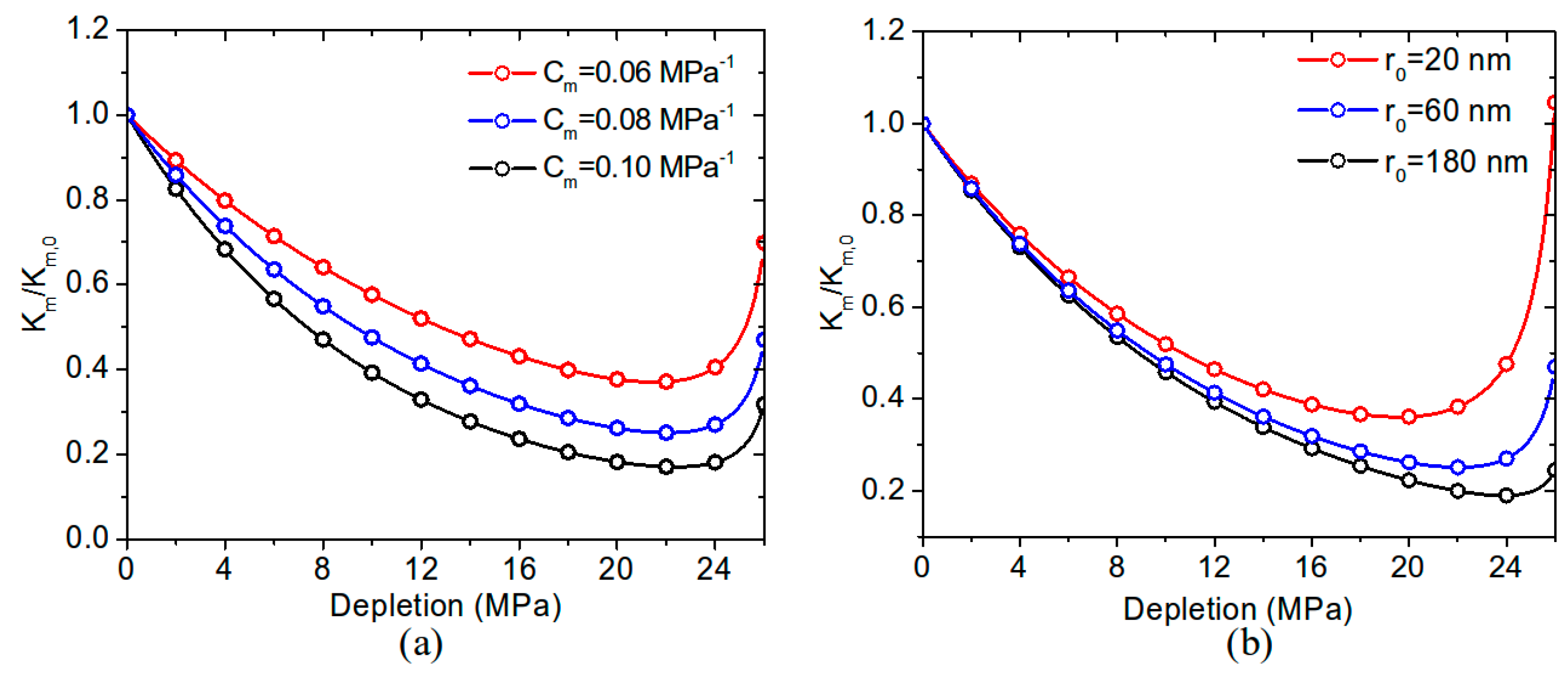
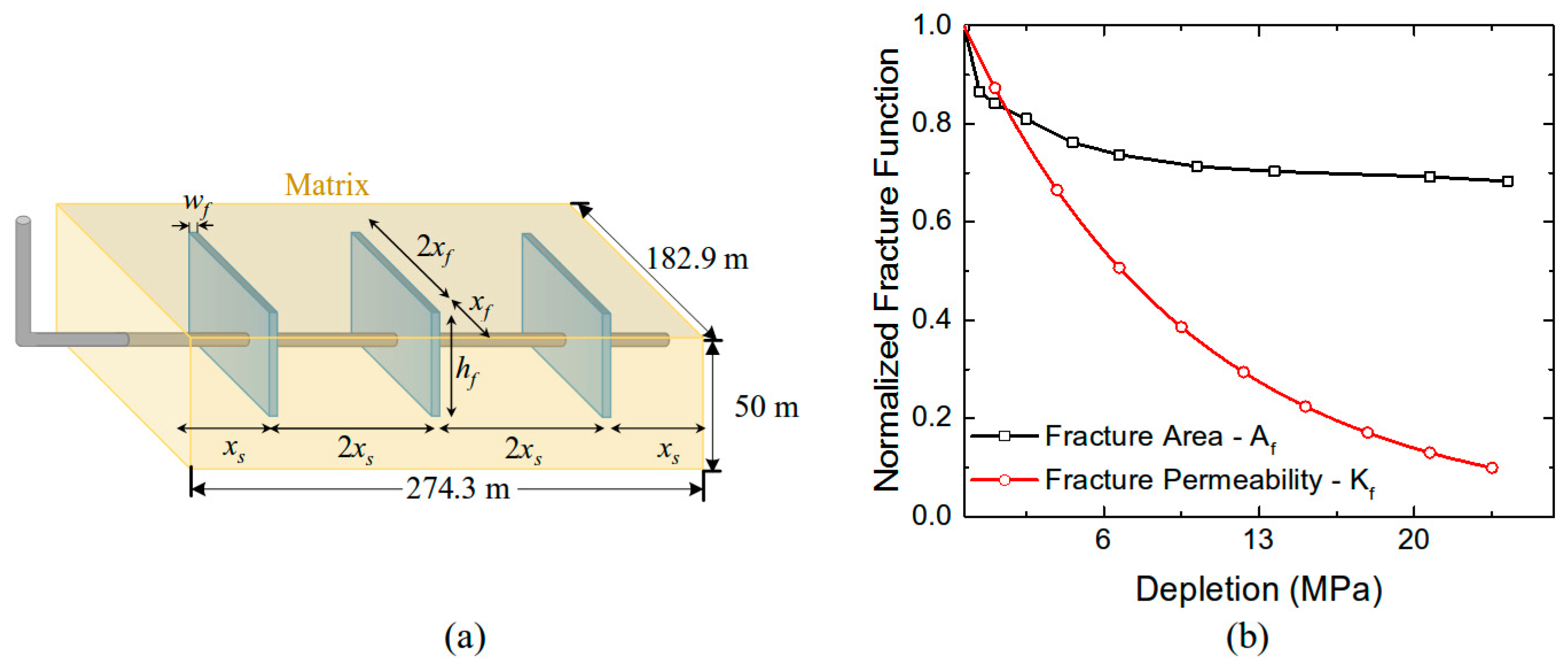
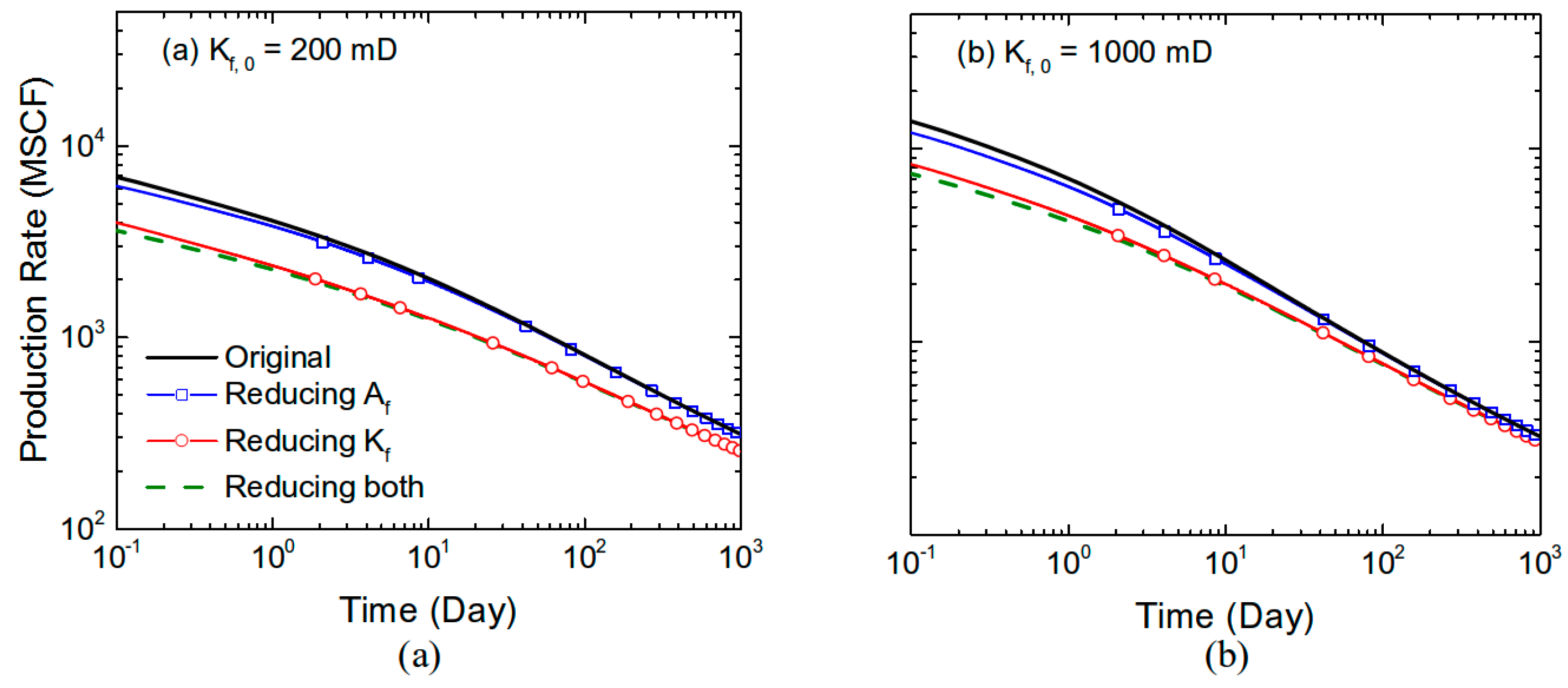
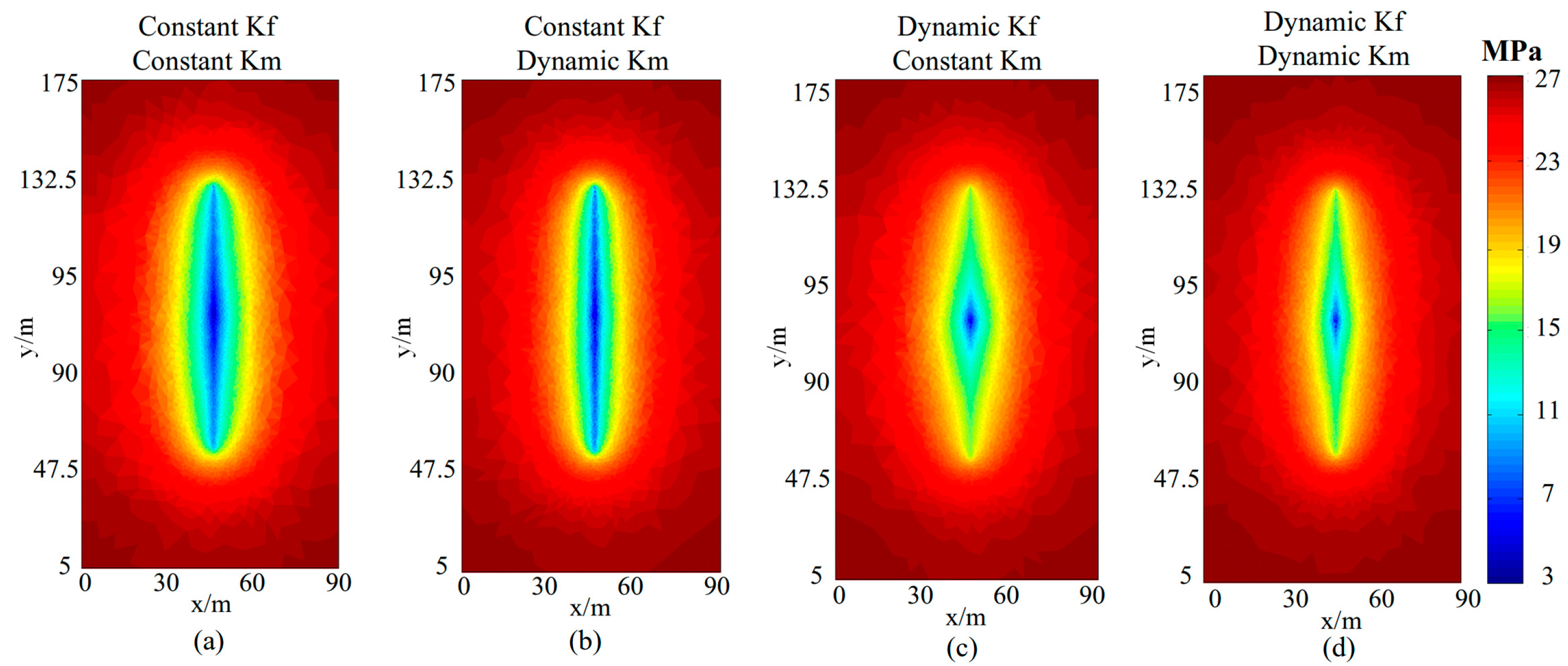


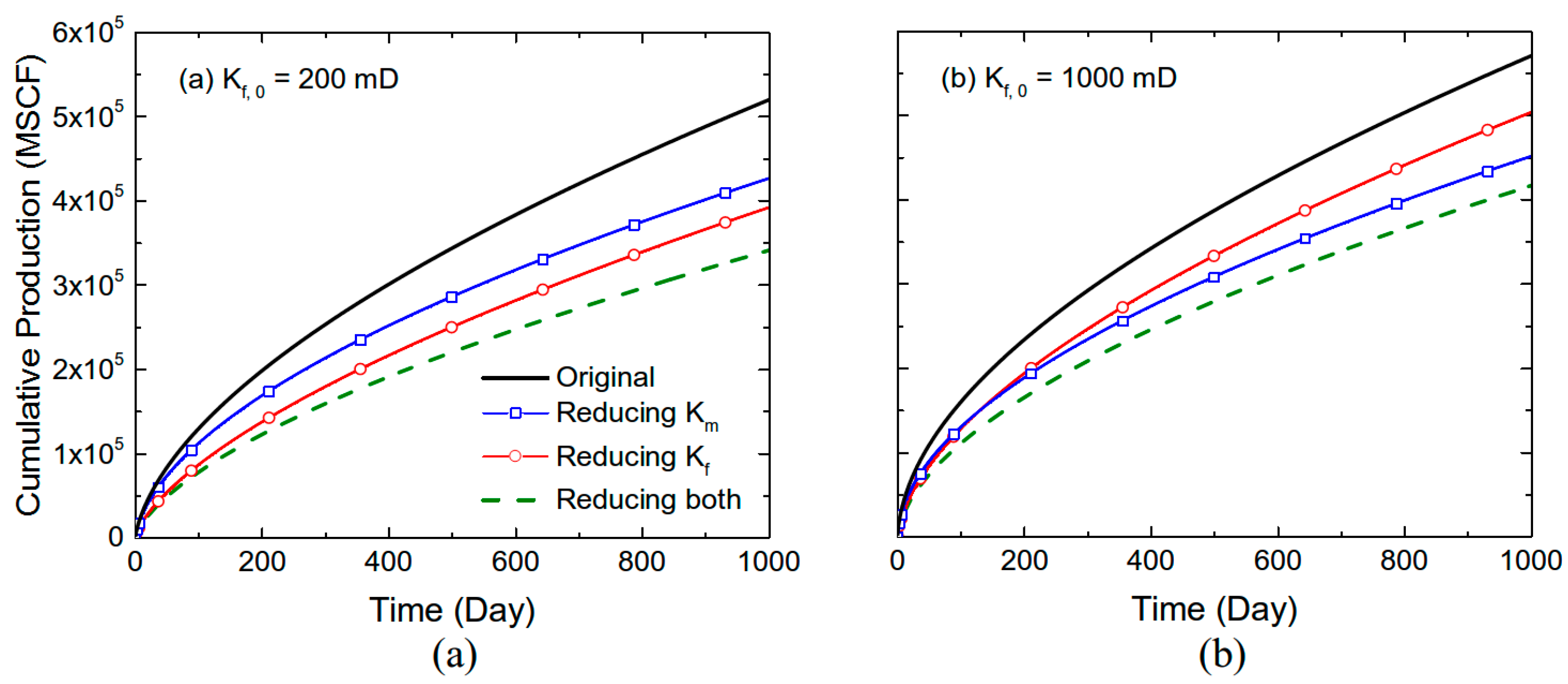
| Parameter | Description | Unit | Value |
|---|---|---|---|
| pinit | initial pressure | MPa | 26.9 |
| pw | well pressure | MPa | 3.4 |
| hf | fracture height | m | 50 |
| μg | gas viscosity | cp | 0.02 |
| initial matrix permeability | nD | 500 | |
| φm | matrix porosity | - | 0.06 |
| v | Poisson’s ratio | - | 0.2 |
© 2017 by the authors. Licensee MDPI, Basel, Switzerland. This article is an open access article distributed under the terms and conditions of the Creative Commons Attribution (CC BY) license (http://creativecommons.org/licenses/by/4.0/).
Share and Cite
Tang, H.; Di, Y.; Zhang, Y.; Li, H. Impact of Stress-Dependent Matrix and Fracture Properties on Shale Gas Production. Energies 2017, 10, 996. https://doi.org/10.3390/en10070996
Tang H, Di Y, Zhang Y, Li H. Impact of Stress-Dependent Matrix and Fracture Properties on Shale Gas Production. Energies. 2017; 10(7):996. https://doi.org/10.3390/en10070996
Chicago/Turabian StyleTang, Huiying, Yuan Di, Yongbin Zhang, and Hangyu Li. 2017. "Impact of Stress-Dependent Matrix and Fracture Properties on Shale Gas Production" Energies 10, no. 7: 996. https://doi.org/10.3390/en10070996
APA StyleTang, H., Di, Y., Zhang, Y., & Li, H. (2017). Impact of Stress-Dependent Matrix and Fracture Properties on Shale Gas Production. Energies, 10(7), 996. https://doi.org/10.3390/en10070996






